The OnePlus 3 Review
by Brandon Chester on June 20, 2016 8:00 AM EST- Posted in
- Smartphones
- OnePlus
- OnePlus 3
Display
Update: OnePlus has since addressed the issues with calibration. Click here for my follow-up article.
One of the most disappointing aspects of the OnePlus 2 was its display. Like the OnePlus One it was a 5.5” IPS LCD display, but the similarities ended there. The OnePlus One shipped with a very well calibrated display, and at the time that wasn’t something you could always expect from devices priced around $300. With the OnePlus 2 the display got a much appreciated boost in peak brightness, but the color accuracy regressed severely. The display was heavily blue shifted, and to say that it tied the Nexus 6 as the most inaccurate display tested in recent years would actually be generous. With how good the display on the OnePlus One was, the OnePlus 2 was a huge letdown.
The OnePlus 3 is a chance for OnePlus to fix the mistakes they made with the OnePlus 2. Like the past two OnePlus flagship devices, we’re still talking about a 5.5” display. However, OnePlus has moved to an AMOLED panel. OnePlus calls this an Optic AMOLED display, although they don’t go into much detail on what that means, beyond claiming that the display uses “Custom-engineered gamma corrections that help create a more natural viewing experience”. It’s generally not a good sign when the description of a technology is very vague and just throws in some technical jargon instead of quantifying and explaining what is actually going on. OnePlus also claims that the display “produces colors that are more vivid and true-to-life than other AMOLED displays”, which sounds like good news given how accurate the AMOLED displays on other smartphones already are.
Before covering display accuracy, I want to comment on OnePlus's use of a 1080p AMOLED panel. According to comments made by OnePlus, a 1080p display was chosen as it provides superior battery life, and because resolutions above 1080p are not useful outside of VR. I have to respectfully disagree with both points, especially because this is a PenTile AMOLED display. It has been well demonstrated that good battery life is achievable not just with 1440p AMOLED smartphones, but with 1440p LCD smartphones. While I do feel 1080p is a good resolution to choose for a 5.5" RGB LCD panel, it is simply not adequate for a PenTile AMOLED display.
When you consider the effective resolution of red and blue on the OnePlus 3, you're really dealing with a display that is roughly equivalent to the iPhone 6s in chroma resolution, except on a 5.5" display instead of a 4.7" one. The resolution for green is equivalent to a 1080p display, and subpixel rendering is what allows you to make the claim that it's still a 1080p display, but for everything except pure green your effective resolution is going to be lower. In addition to that, the uneven size and spacing of the subpixels, along with their diamond pattern, makes them less than optimal for rendering the latin alphabet which contains many vertical lines. This kind of screen door effect has long been noticed on PenTile displays, and for the most part the push for 1440p AMOLED panels has mitigated those complaints.
On the OnePlus 3 it's pretty obvious that text is rendered less clearly than the iPhone 6s, which has a pixel density of only 326ppi, well below that of flagship Android devices. With the OnePlus One and OnePlus 2 for comparison it's completely obvious that the OnePlus 3 has a lower effective resolution, with text exhibiting distracting artifacts, and solid patterns that are red, blue, or white having a crosshatch pattern that simply isn't visible on OnePlus's older smartphones. I completely agreed with OnePlus's choice of 1080p on their past smartphones, but saying that there's no benefit to going higher on a PenTile AMOLED display is simply false, and there's no getting around the fact that the OnePlus 3 has a lower effective resolution than its predecessors.
While OnePlus isn't off to a great start with their display resolution, there are many other aspects of a display that need to be considered beyond the number of pixels. To examine the OnePlus 3’s display I’ve run our standard display workflow on it. As always, measurements are performed with an i1Pro 2 spectroradiometer, with the exception of contrast which is done with an i1Display Pro colorimeter. Data is collected and managed with SpectraCal’s CalMAN 5 software.
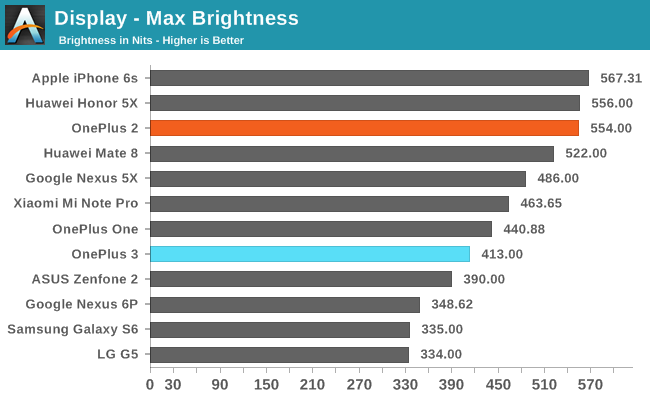
Right out of the gate things are not looking good for the OnePlus 3. Peak brightness only hits 413 nits, which is a huge regression from the OnePlus 2’s 554 nits. The impact that this has on outdoor usability is very significant, with the display being much harder to use in the sun than the OnePlus 2. To make matters worse, there’s no brightness boost mode that activates when you have the auto-brightness on. At this point I really don’t think it’s acceptable to ship a phone that can’t hit 500 nits when you’re in the sun, and Samsung is pushing 600 nits on their AMOLED displays when they boost brightness so OnePlus is well behind the competition.
Given that the OnePlus 3 uses an AMOLED display, you technically have infinite contrast when there’s no ambient light. In practice the OnePlus 3 definitely has better black levels than any LCD device that I own, but the OnePlus 2 still had a great static contrast ratio, and the better blacks weren’t worth sacrificing the 550 nit peak brightness at all.
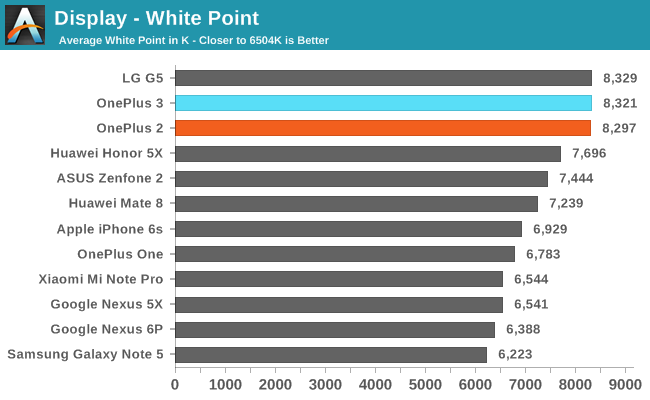
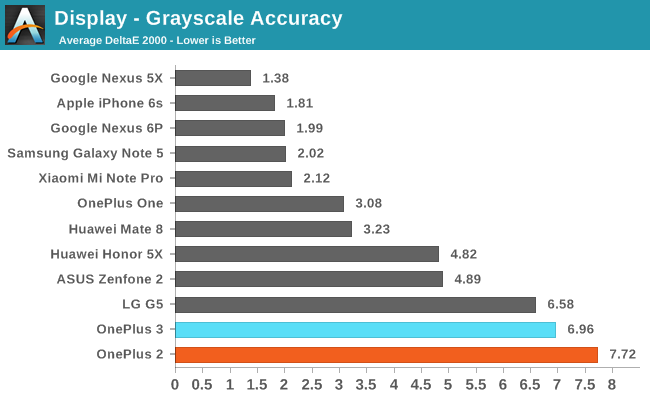
Greyscale accuracy on the OnePlus 3 is very poor. It’s not as bad as the OnePlus 2, but given how severe the errors are, it’s entirely possible that I just happened to get an exceptionally bad OnePlus 2 unit and an exceptionally good OnePlus 3. Whatever the case may be, the OnePlus 3 still has severe issues with greyscale rendition. Gamma is somewhat more accurate than the OnePlus 2 that I received, but the display has even more severe blue shifting, and it’s immediately apparent right from the very first setup screen when you turn on the phone.
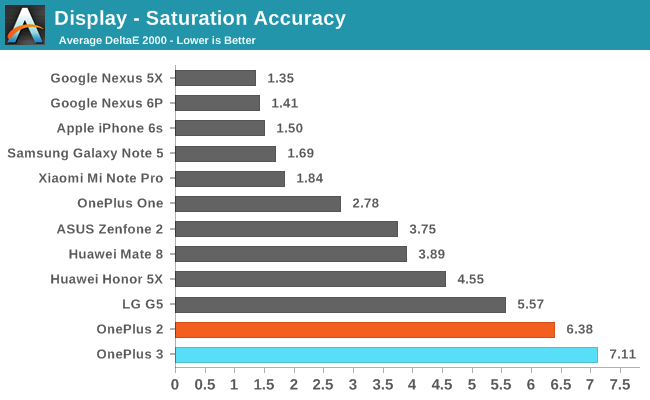
In the saturation sweep test, the OnePlus 3 performs even more poorly than the OnePlus 2. You can tell from the gamut that they’re actually targeting NTSC, which makes me feel like I’ve been sent back in a time machine to 2010 where this was the problem with AMOLED displays on smartphones like the Nexus One and the original Galaxy S. I really thought that we had moved past this, past the point where AMOLED phones would ship with nonsensical gamut targets that you can’t change, but clearly I was wrong.
What I really don’t understand is why the NTSC gamut was chosen as the target. With very old AMOLED phones this was chosen under the mistaken belief that NTSC was the correct gamut to use for displaying videos on smartphones, which was absolutely wrong. The gamut defined in the NTSC standard is over sixty years old, it was never even reproduced properly on the CRT displays of the time because they couldn’t do so with an adequate brightness level, and it was replaced as a “standard” gamut decades ago, basically not ever being used outside the Americas at all. When a smartphone targets Adobe RGB you can at least see the misguided but well-intentioned attempt to give a wider gamut using a color standard that actually is used in some cases, but when NTSC is the target it just shows a severe lack of understanding of modern displays and color standards.
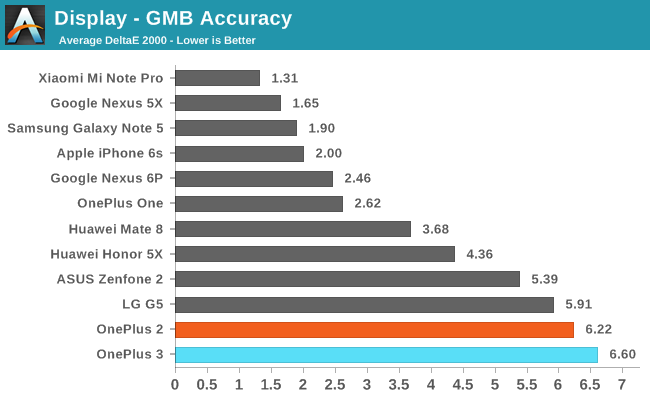
With poor greyscale and color reproduction, there’s absolutely no hope for proper color mixture rendition. As expected, the OnePlus 3 also regresses here, and beats the OnePlus 2 as the most inaccurate display on the chart. I really don’t have anything else to say here, as I’m just so frustrated by OnePlus’s choices here.
It’s evident that OnePlus didn’t learn from the issues I demonstrated with the OnePlus 2’s display. It was a serious regression from the OnePlus One, and with the OnePlus 3 they’ve somehow found a way to regress even further. Of all the aspects of a phone to mess up, the display is the absolute worst. There’s basically no use case where you use a phone without looking at the screen, and right from the very first moment I turned on the OnePlus 3 I could tell that the colors are completely wrong. It’s just a huge disappointment.
There is one glimmer of hope. After reaching out to OnePlus, explaining why the choice of the NTSC color space as a target doesn't make any sense, and showing the errors it causes with sRGB rendition, they told me that they now intend to offer an sRGB mode as an option in an upcoming OTA update. There's no firm timeline for this which makes me uneasy, and I can't make a recommendation based on an update that isn't guaranteed, but it's worth making note of. Unfortunately, I am unsure of whether or not this is something that can be fixed after the phone has already shipped. OnePlus has left the display extremely blue which is often indicative of little or no white point calibration, which would mean it's impossible to tune the phones because you don't even have an idea of what the panel characteristics are. For that reason, I remain hopeful but somewhat skeptical, and I plan to revisit the display of the OnePlus 3 if and when OnePlus adds this feature.
While an sRGB mode may be coming, right now the display accuracy you get on the OnePlus 3 reminds me a great deal of early AMOLED devices from 2010, and that's not a good thing at all. I really expected OnePlus to fix their mistakes from the OnePlus 2 because they did so with so many other aspects of the phone. The only explanation I can think of is that nobody actually understood the negative impact of shipping a wide gamut display on a non-color-managed operating system. This actually seems like the most likely explanation, as the choice of NTSC as the target gamut was definitely not an informed decision. Regardless of what path led to the OnePlus 3's current display, the end result is that the poor display calibration ruins the phone for me, because the screen is just unpleasant to look at. If display accuracy doesn’t matter at all to you it may be possible to overlook it, but for anyone who cares even the slightest bit the issues with the OnePlus 3’s display will be too severe to live with.



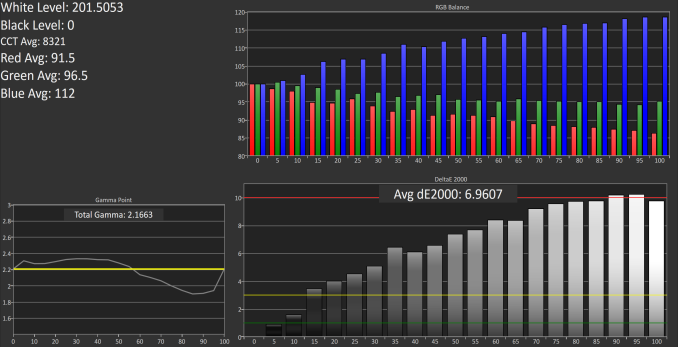

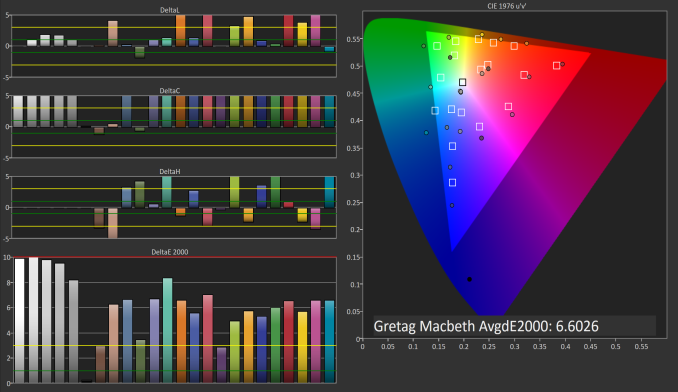








176 Comments
View All Comments
thek - Monday, June 20, 2016 - link
Regarding the last line - what I mean is that even if those companies flagships have slight bumps they should still be highly recommended for the sake of maybe making other big companies charge less for their phones (which they obv can do if this one costs 400$), or provide more for that same amount of money. They don't innovate because we just don't give them enough hard time for providing the same phone every year but with just more gimmicks, and not practical things like battery sizes and storage10basetom - Monday, June 20, 2016 - link
If they really want to help consumers save money, they should've gone with 3GB of RAM and keep the same $349 price tag. That extra 3GB is mostly for show at the moment (except maybe when you're playing 3D games).thek - Monday, June 20, 2016 - link
again, going for the one that tried to do something good.why not take the argument to apple for having only 2GB (or 1!!!!!) up until a year ago or to Samsung (and of course, Apple again) for keeping the batteries at a pathetic 2000-3000~ mark when they can provide much more if they wanted?
''why 6'' is a worse argument than ''why only 2''.
LukaP - Monday, June 20, 2016 - link
(speaking about ram now)Because, in case you havent noticed, the iPhones up until last year, didnt need more than a gig of ram, and still perform great with 2gigs, so why increase BOM and power usage for silly specs?
As for the batteries, these are very much parts that are dependent on the design of a phone. Sure they could slap in a 6000mAh battery into the next Galaxy, but then people like you, if not you, would be complaining here taht the phone is heavy and feels like a brick.
I personally dont have a problem with smaller batteries/ram amounts/resolutions if it doesnt compromise the user experience. and speaking from a perspective of an iPhone SE owner, the lower resolution screen is not noticable, the low battery capacity provides me more usable time than any Galaxy S device ive had before, and multitasking is faster and much less disruptive than it has ever been, despite "only" 2 gigs of RAM.
So why bash them for stupid "features"? Because either they could not include them, and save money, or not include them, adn spend that money on something that really matters, like a better screen, or atleast in factory calibration of what they have now.
UtilityMax - Monday, June 20, 2016 - link
The claim that iPhones like the 6, didn't need more than 1GB, even last year, is just BS. I had iphones with 1GB of RAM, and the apps and the tabs inside the web browsers kept reloading without any warning, sometimes losing data all the time. Yes, Apple did clever things to make sure the phone doesn't literally run out of memory, but multitasking was horrible. Moreover, It's truly ridiculous that a former flagship phone like iPhone 6 is no longer future proof, even though it's only two years old.Buk Lau - Monday, June 20, 2016 - link
there's a difference between "having 6GB of RAM" and "having 6GB but only limiting usage to something lower." what oneplus is doing is simply limiting RAM usage on the kernel level to something lower than 6; if that's the case, why have 6GB of RAM at all? what's the point if I pay for 6GB but can't use all of it at my will? oneplus said they are doing to save battery, but if that's the case why not just take off 2GB and use that money for a bigger battery? "why 6" isn't the argument here, it's "why 6 when only use 4?"melgross - Monday, June 20, 2016 - link
Because iOS functions differently. Android keeps apps open, and running, when you aren't using them, when they don't need to, absorbing RAM, processor cycles and battery power. Except for apps that need to do work in the background, iOS doesn't keep them open. Sometimes I have 50 apps in the que, but they're not actually open. The state of the apps are kept, and when we go to them again, it seems as though they were open.This is why iOS needs less RAM than Android.
UtilityMax - Wednesday, June 22, 2016 - link
But iOS keeps killing the apps and reloading the web browser tabs so aggressively that it really affects the usability. The 1GB iPhones are getting pretty much useless to me right now, because all they spend most of their time on, seemingly, is to reload the web browser tabs, silently, sometimes losing my data. I never run into such issues with the Android phones with 2GB of memory. What iOS did was simply a hack to hide the facts that iPhone 6 shipped with an inadequate amount of RAM.UtilityMax - Wednesday, June 22, 2016 - link
2-3GB of RAM is more than adequate. But 6GB is pretty much ridiculous. Ask any power-user or any price conscious user, and they would probably tell you that they would gladly trade the 3GB of Oneplus 3's RAM for better screen or an sd card slot or more battery life. 6GB is pretty much superflous at this point.LiverpoolFC5903 - Tuesday, June 21, 2016 - link
RAM is cheap though, as you can see by the glut of sub 300 USD phones from China with 3/4 GB RAM and weak processors. Even phones with a processor as weak as the Mt 6753 have 3GB at least these days. That extra 3 gb should no have added all that much to the bom, especially compared to the SOC and Display.Companies who gimp on RAM do it because they want to create sub segments and not because it adds a lot to the bom.
In any case, 2GB is more than sufficient for anything in Android, anything above is a waste. I dont need 100 apps in memory, no thanks. 6 GB is ridiculous overkill imho.